Vocabulary
Indirect Measurement- a method of using proportions to find an unknown length or distance in
similar figures.
Examples
Another category of proportion problem is that of "similar figures".
"Similar" is a geometric term, referring to geometric shapes that are the same, except that one is larger than the other. Think of what happens when you use the "enlarge" or "reduce" setting on a copier, or when you get an eight-by-ten enlargement of a picture you really like, and you'll have the right idea. If you've used a graphics program, think "aspect ratio".
| In the context of
ratios and proportions, the point is that the corresponding sides
of similar figures are proportional. For instance, look at the similar triangles at the right: The "corresponding sides" are the pairs of sides that match", except for the enlargement / reduction aspect of their relative sizes. So A corresponds to a, B corresponds to b, and C corresponds to c.
Since
these triangles are similar, the pairs of corresponding sides are
proportional. That is, A : a = B : b = C : c. This
proportionality of corresponding sides can be used to find the length
of a side of a figure.
|
 |
- In the displayed triangles, the lengths of the sides are given by A = 48 mm, B = 81 mm, C = 68 mm, and a = 21 mm. Find the lengths of sides b and c, rounded to the nearest whole number.
I'll set up my proportions, using ratios in the form (big triangle length) / (little triangle length), and then I'll solve the proportions. Since I have the length of only side a for the little triangle, my reference ratio will be A : a.
First,
I'll find the length of b.
b × 48 = 21 × 81
48b = 1701 b = 35.4375 |
 |
Now I'll
find the length of c.
Copyright © Elizabeth Stapel
2001-2011 All Rights Reserved
ADVERTISEMENT
|
|
c × 48 = 21 × 68
48c = 1428
c = 29.75
48c = 1428
c = 29.75
For my answer,
I could just slap down the two numbers I've found, but those numbers
won't make much sense without their units. Also, in re-checking the
original exercise, I notice that I'm supposed to round my values to
the nearest whole number, so "29.75",
with or without units, would be wrong. The right answer is:
b = 35 mm and c = 30 mm.
- A picture measuring 3.5" high by 5" wide is to be enlarged so that the width is now 9 inches. How tall will the picture be?
- In other words, the photo
lab will be maintaining the aspect ratio; the rectangles representing
the outer edges of the pictures will be similar figures. So I set up
my proportion and solve:
9 × 3.5 = 5 × h
31.5 = 5h
6.3 = h
For many exercises, you will be able to set up your ratios and proportions in any of various ways. Just make sure that you label things well, clearly define your variables, and set things up in a sensible and consistent manner; this should help you dependably reach the correct solutions. If you're ever not sure of your solution, remember to plug it back into the original exercise, and verify that it works.
http://www.purplemath.com/modules/ratio6.htm
Video Help
https://www.youtube.com/watch?v=1UuiF3mskQA
https://learnzillion.com/lessons/4028-determine-if-two-figures-are-similar-using-transformations-and-dilations
https://www.youtube.com/watch?v=LhEe0kB4QIs

No comments:
Post a Comment